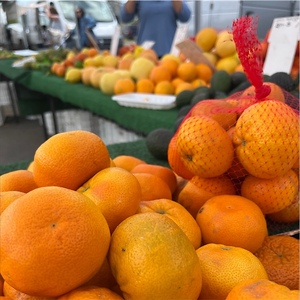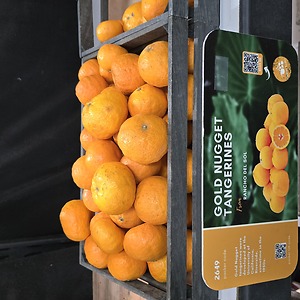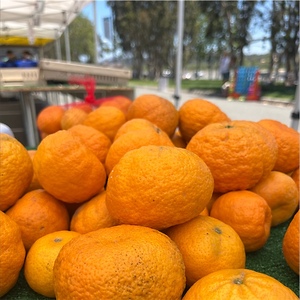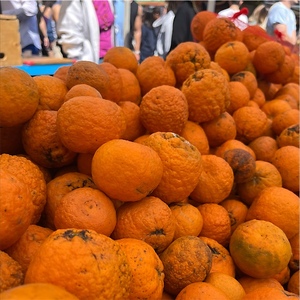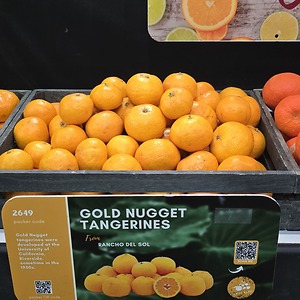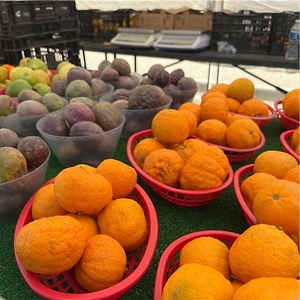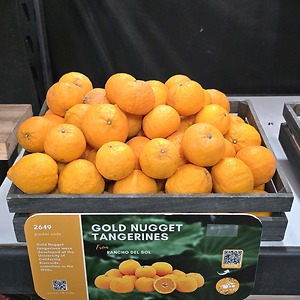


Gold Nugget Tangerines
Estimated Inventory, lb : 61.02
This item was last sold on : 07/17/25
Description/Taste
Gold Nugget tangerines are a medium to large variety, averaging 5 to 8 centimeters in diameter, and have a slightly flattened, oblate to round shape without a distinct neck. The pale to golden-orange fruits have a textured surface, ranging from glossy and finely pitted with depressed oil glands to semi-coarse and externally bumpy, depending on the cultivation methods used and tree maturity. The rind is also somewhat easy-to-peel, releasing bursts of fragrant oils when torn. Once removed, it reveals a bright orange flesh divided into 9 to 10 segments by thin, white membranes. The flesh is soft, tender, aqueous, and mostly seedless. Gold Nugget tangerines have high sugar content balanced by mild acidity, creating a sweet, fruity, and subtly tangy flavor.
Seasons/Availability
Gold Nugget tangerines are available in the late winter through early summer.
Current Facts
Gold Nugget tangerines, botanically classified as Citrus reticulata, are a mid to late-season citrus variety belonging to the Rutaceae family. The golden-orange fruits were whimsically named for their unique coloring and bumpy rind and are highly favored among citrus enthusiasts for their juicy, sweet, and seedless nature. Gold Nugget tangerines are also known as Gold Nugget mandarins and come into season when many other mandarin varieties are leaving the market. The variety’s long harvest season and ability to store well on the tree provides fresh, tender fruits into the summer season. Despite the fruit’s unusual bumpy appearance, Golden Nugget tangerines have widely increased in popularity as a fresh eating variety and are expanding in cultivation worldwide to meet growing market demand.
Nutritional Value
Gold Nugget tangerines are an excellent source of fiber to stimulate the digestive tract, vitamin C to strengthen the immune system, and folate to produce healthy red blood cells. The fruits also provide vitamin A to maintain optimal organ functioning, antioxidants to protect against free radical damage to cells, potassium to balance fluid levels within the body, and lower amounts of calcium to strengthen bones and teeth.
Applications
Gold Nugget tangerines have a sweet flavor and juicy consistency well-suited for fresh preparations. The fruits can be easily peeled and consumed straight, out-of-hand, or they can be tossed into green and fruit salads, blended into smoothies and shakes, or incorporated into grain and cereal bowls. Gold Nugget tangerines are also a popular juicing variety, using the liquid in cocktails, sparkling beverages, fruit punches, or mixing into dressings, sauces, and marinades. In addition to fresh preparations, Gold Nugget tangerines can be cooked into marmalade, jams, and jellies, used as a flavoring in muffins, cakes, bread, and cookies, or frozen into sorbet, ice cream, and popsicles. Gold Nugget tangerines pair well with dried or fresh berries, other citrus including grapefruit, lemons, and blood oranges, meats such as poultry, turkey, and pork, seafood, shallots, fennel, and fresh herbs including mint, basil, and parsley. Whole Gold Nugget tangerines will keep 1 to 2 weeks when stored in a plastic bag in the refrigerator's crisper drawer.
Ethnic/Cultural Info
In the late 1800s, Riverside County became one of California's primary citrus-growing regions, sparking what many experts called the “second gold rush.” Local and out-of-state agricultural workers flocked to the region to pursue newfound citrus opportunities, and over time, Riverside continued to establish itself as a citrus authority with the creation of the Citrus Experiment Station in the early 1900s. In the modern-day, thousands of citrus varieties are currently being studied, grown, and improved at the UC Riverside Citrus Experiment Station, and many new cultivars have been developed and released to commercial growers, including Gold Nugget tangerines. To honor the stories surrounding Riverside's citrus industry, the California Citrus State Historic Park was also established in partnership with the experiment station in 1993. The 248-acre park seeks to record the history of citrus production in Southern California and highlight the voices and stories of the agricultural workers that made the industry thrive. The park features an outdoor museum, picnic area, activity center, and several groves of citrus trees. Tours are offered through the groves, and visitors have the opportunity to sample over 70 varieties of citrus that are grown in the region.
Geography/History
Gold Nugget tangerines were developed at the University of California, Riverside, sometime in the 1950s. The hybrid fruit was created from a cross between non-commercial breeding varieties, kincy and wilking mandarins, and these parent cultivars were also hybrids of mandarins and tangors. Gold Nugget tangerines were selected for commercial cultivation in 1975 by J.W. Cameron and D.K. Soost and were sent to the Lindcove Research and Extension Center in Exeter, California, in 1986 to produce a virus-free budwood source. Today Gold Nugget tangerines can be found through specialty grocers, supermarkets, home gardens, and farmer’s markets in the United States, Spain, Australia, and New Zealand.
Featured Restaurants
Restaurants currently purchasing this product as an ingredient for their menu.
| Urban Corps Charter School | San Diego CA | 619-235-6884 |
| The Seabird Resort | Oceanside CA | 442-222-9505 |
| Sago | Encinitas CA | 858-382-4047 |
| Vista Valley | Vista CA | 760-758-2800 |
| Vertex - Merryfield Row | San Diego CA | 619-405-8950 |
| Searcher Sportfishing | San Diego CA | 619-861-4640 |
| Lauberge Del Mar | Del Mar CA | 858-259-1515 |
| Dr Bronner's Magic Soaps | Vista CA | 760-975-7327 |
| Cal A Vie | Vista CA | 760-945-2055 |
| Mission Pacific | Oceanside CA | 760-450-7864 |
| Institutes of Health LLC | San Diego CA | 800-270-5016 |
| Hazel & Jade Bakery | San Diego CA | 804-815-8052 |
| Born & Raised | San Diego CA | 619-944-1631 |
| Park Hyatt Aviara | Carlsbad CA | 760-448-1234 |
| Golden Door | San Marcos CA | 760-761-4142 |
| Herb & Sea (Bar) | Encinitas CA | 858-587-6601 |
| Noble Experiment | San Diego CA | 619-446-0002 |
| Reata Glen | Ladera Ranch CA | 949-545-2250 |
| Sonny's Pizza | San Diego CA | 619-432-1838 |
| Paradisaea Dodo Bird | La Jolla CA | 732-915-6669 |
| Fairmont Grand Del Mar | San Diego CA | 858-314-1975 |
| The Whaling Bar (Bar) | La Jolla CA | 858-355-9218 |
| Convention Center Shell | San Diego CA | 619-954-3063 |
| InterContinental Vistal Kitchen | San Diego CA | 619-501-9400 |
| The Kitchen at MCASD | La Jolla CA | 619-880-8719 |
| Bridges at Rancho Santa Fe | Rancho Santa Fe CA | 858-759-6063 |
| Farmer and The Seahorse | San Diego CA | 619-302-3682 |
| Copper Kings | San Marcos CA | 323-810-1662 |
Recipe Ideas
Recipes that include Gold Nugget Tangerines. One







